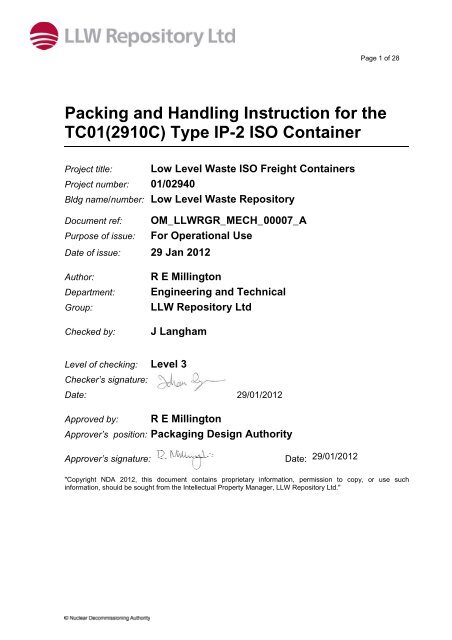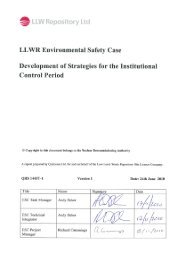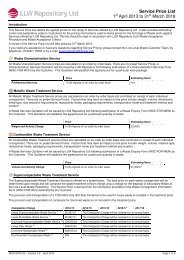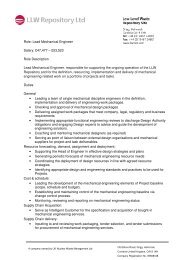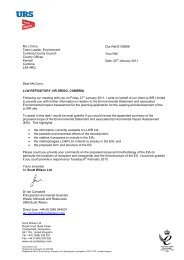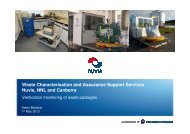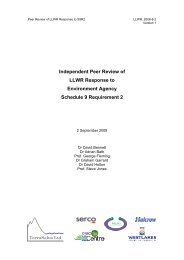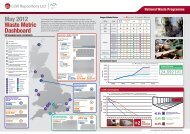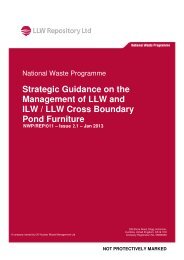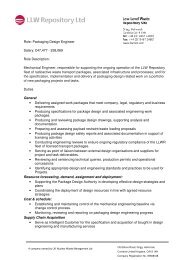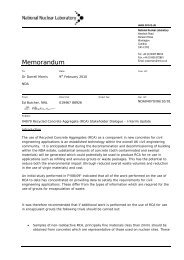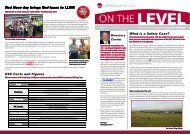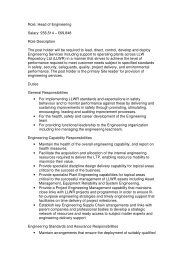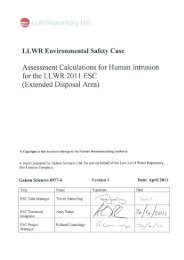Packing and Handling Instruction for the TC01(2910C) Type IP-2 ...
Packing and Handling Instruction for the TC01(2910C) Type IP-2 ...
Packing and Handling Instruction for the TC01(2910C) Type IP-2 ...
Create successful ePaper yourself
Turn your PDF publications into a flip-book with our unique Google optimized e-Paper software.
Page 1 of 28<strong>Packing</strong> <strong>and</strong> H<strong>and</strong>ling <strong>Instruction</strong> <strong>for</strong> <strong>the</strong><strong>TC01</strong>(<strong>2910C</strong>) <strong>Type</strong> <strong>IP</strong>-2 ISO ContainerProject title: Low Level Waste ISO Freight ContainersProject number: 01/02940Bldg name/number: Low Level Waste RepositoryDocument ref: OM_LLWRGR_MECH_00007_APurpose of issue: For Operational UseDate of issue: 29 Jan 2012Author:Department:Group:Checked by:R E MillingtonEngineering <strong>and</strong> TechnicalLLW Repository LtdJ LanghamLevel of checking: Level 3Checker’s signature:Date: 29/01/2012Approved by: R E MillingtonApprover’s position: Packaging Design AuthorityApprover’s signature: Date: 29/01/2012"Copyright NDA 2012, this document contains proprietary in<strong>for</strong>mation, permission to copy, or use suchin<strong>for</strong>mation, should be sought from <strong>the</strong> Intellectual Property Manager, LLW Repository Ltd."
Package <strong>and</strong> H<strong>and</strong>ling <strong>Instruction</strong> <strong>for</strong> <strong>the</strong> <strong>TC01</strong> (<strong>2910C</strong>) <strong>Type</strong> <strong>IP</strong>-2 ISO ContainerPage 2 of 28Name Location No ofcopiesRemarksM. Walkingshaw LLWR 1 3R Millington LLWR 1 3M. Flynn LLWR 1 3M. Coward LLWR 1 3N. Shaw LLWR 1 3Purposeof issueOM_LLWRGR_MECH_00007_A
Package <strong>and</strong> H<strong>and</strong>ling <strong>Instruction</strong> <strong>for</strong> <strong>the</strong> <strong>TC01</strong> (<strong>2910C</strong>) <strong>Type</strong> <strong>IP</strong>-2 ISO ContainerPage 4 of 28ContentsItemPageHistory sheet........................................................................................................................... 3Contents................................................................................................................................... 4Definitions/Glossary ............................................................................................................. 71 Introduction...................................................................................................................... 81.1 General...................................................................................................................................... 81.2 Permissions............................................................................................................................. 81.3 Conditions <strong>for</strong> Restricted Container Reuse .................................................................... 81.4 Temperature Range ............................................................................................................. 102 Scope ............................................................................................................................... 103 Compliance .................................................................................................................... 114 Responsibilities ............................................................................................................ 115 Consignor Pre-Loading Checks ............................................................................... 115.1 General.................................................................................................................................... 115.2 Certificate of Approval ........................................................................................................ 115.3 Container Body <strong>and</strong> Lid...................................................................................................... 115.4 Vent <strong>and</strong> Grout Ports........................................................................................................... 125.5 CSC Plate................................................................................................................................125.6 Decals...................................................................................................................................... 125.7 Paint Finish ............................................................................................................................ 125.8 Lid Removals......................................................................................................................... 125.9 Lid Seals, Seal Faces <strong>and</strong> Seal Support Channels...................................................... 136 Container H<strong>and</strong>ling Operations................................................................................ 136.1 General.................................................................................................................................... 136.2 H<strong>and</strong>ling Methods ................................................................................................................ 136.3 Container Restraint.............................................................................................................. 146.4 Lifting <strong>and</strong> Loading Equipment ........................................................................................ 146.5 Lifting using a Fork Lift Truck........................................................................................... 146.6 Lifting Using Bottom Corner Fittings.............................................................................. 146.7 Lifting Using Top Corner Fittings .................................................................................... 146.8 Maximum Stacking Height ................................................................................................. 146.9 Lifting Container Lid............................................................................................................ 14OM_LLWRGR_MECH_00007_A
Package <strong>and</strong> H<strong>and</strong>ling <strong>Instruction</strong> <strong>for</strong> <strong>the</strong> <strong>TC01</strong> (<strong>2910C</strong>) <strong>Type</strong> <strong>IP</strong>-2 ISO ContainerPage 5 of 28ContentsItemPage7 Loading <strong>the</strong> Container................................................................................................. 157.1 Positioning of Container..................................................................................................... 157.2 Environmental Consideration ........................................................................................... 157.3 Protecting Seals.................................................................................................................... 157.4 Loading ................................................................................................................................... 157.4.1 General (to be complied with in all Case) ...................................................................... 157.4.2 Large Items ............................................................................................................................ 157.4.3 Use of Tie Down <strong>and</strong> Restraint Systems........................................................................ 157.4.4 Additional Requirements when Loading <strong>for</strong> Disposal................................................ 167.4.5 Additional requirement when transporting waste to Treatment Facilities underLLWR Waste Services Contract ........................................................................................................... 167.4.6 Recommendation when transporting waste not under LLWR Waste ServicesContract 168 Pre-dispatch Checks.................................................................................................... 168.1 Prior to Closing <strong>the</strong> Lid....................................................................................................... 168.2 Closing <strong>the</strong> Lid...................................................................................................................... 178.3 After Closing <strong>the</strong> Lid............................................................................................................ 178.4 Monitoring <strong>and</strong> Labelling ................................................................................................... 178.5 Documentation...................................................................................................................... 179 Storage of Containers ................................................................................................. 179.1 Storage of Empty Containers............................................................................................ 179.2 Container Retrieval from Storage .................................................................................... 1810 References................................................................................................................. 18Figure 1: General view of <strong>TC01</strong>....................................................................................... 19Figure 2: Lifting Using Bottom Fittings ......................................................................... 20Figure 3: Lifting Using Top Fittings................................................................................ 21Figure 4: Trailer Support ................................................................................................... 22Figure 5: Lid Lifting & Set Down Criteria ...................................................................... 23Figure 6: Lid Seals <strong>and</strong> Seal Protection ........................................................................ 24Figure 7: Lid Positioning ................................................................................................... 25Figure 8: Twistlock System on Trailer ........................................................................... 26OM_LLWRGR_MECH_00007_A
Package <strong>and</strong> H<strong>and</strong>ling <strong>Instruction</strong> <strong>for</strong> <strong>the</strong> <strong>TC01</strong> (<strong>2910C</strong>) <strong>Type</strong> <strong>IP</strong>-2 ISO ContainerPage 6 of 28ContentsItemPageFigure 9: Spacer <strong>for</strong> use when stacking containers .................................................. 27Appendix A Container Specification .............................................................................. 28OM_LLWRGR_MECH_00007_A
Package <strong>and</strong> H<strong>and</strong>ling <strong>Instruction</strong> <strong>for</strong> <strong>the</strong> <strong>TC01</strong> (<strong>2910C</strong>) <strong>Type</strong> <strong>IP</strong>-2 ISO ContainerPage 7 of 28Definitions/GlossaryACEPApproved Continuous Examination ProgrammeADRALARPApproving AuthorityConsignorContainer OperatorContract AuthorityCSCDesign AuthorityInspection AuthorityIAEAEuropean Agreement concerning <strong>the</strong> carriage of DangerousGoods by RoadAs Low As Reasonably PracticableLLWR Container Approval Authority is responsible <strong>for</strong> <strong>the</strong>issue of Certificates of Approval <strong>for</strong> IAEA self assessmentcontainer types on behalf of LLWRConsignor according to <strong>the</strong> provisions of ADROwner of <strong>the</strong> ContainerLLW Repository Ltd(International) Convention <strong>for</strong> Safe ContainersHead of Engineering LLW Repository Ltd., Holmrook,CumbriaAn Inspection organisation approved by <strong>the</strong> Health & SafetyExecutive to approve designs as meeting ISO <strong>and</strong> CSCrequirements.International Atomic Energy Agency.<strong>IP</strong>-2 Industrial Container <strong>Type</strong> 2ISOLLWLLWRLSAManufacturerSCOSQEPUDLWACInternational St<strong>and</strong>ards Organisation.Low Level WasteLow Level Waste RepositoryLow Specific ActivityThe organisation responsible <strong>for</strong> producing hardware inaccordance with <strong>the</strong> requirements of <strong>the</strong> Contract Authority.Surface Contaminated ObjectSuitably Qualified <strong>and</strong> Experienced PersonUni<strong>for</strong>mly Distributed LoadWaste Acceptance CriteriaOM_LLWRGR_MECH_00007_A
Package <strong>and</strong> H<strong>and</strong>ling <strong>Instruction</strong> <strong>for</strong> <strong>the</strong> <strong>TC01</strong> (<strong>2910C</strong>) <strong>Type</strong> <strong>IP</strong>-2 ISO ContainerPage 8 of 281 Introduction1.1 General1.1.1 This document provides <strong>the</strong> relevant parties (Consignors, Consignees & Inspection)guidance regarding <strong>the</strong> O&M requirements <strong>for</strong> <strong>the</strong> LLW Repository Ltd, IndustrialPackage <strong>Type</strong> 2 (<strong>IP</strong>-2), Package Design <strong>TC01</strong>.1.1.2 The container is designed <strong>for</strong> <strong>the</strong> transport <strong>and</strong> disposal of solid radioactive materialin <strong>the</strong> <strong>for</strong>m of LLW con<strong>for</strong>ming to LSA or SCO material as defined in <strong>the</strong> IAEASafety St<strong>and</strong>ard Series TS-R-1, Regulations <strong>for</strong> <strong>the</strong> Safe Transport of RadioactiveMaterial, 2009 Edition [1]. Each container is supplied as an Industrial Package <strong>Type</strong>2 (<strong>IP</strong>-2) container. The explicit use <strong>and</strong> restrictions of <strong>the</strong> packaging are defined in<strong>the</strong> Certificate of Approval issued by <strong>the</strong> Package Approval Authority, LLWRepository Ltd.Note: Where it is found that any part of <strong>the</strong> <strong>Packing</strong> <strong>and</strong> H<strong>and</strong>ling <strong>Instruction</strong>scannot be complied with <strong>the</strong> container shall be embargoed <strong>and</strong> advice shall besought from <strong>the</strong> Contract Authority.1.1.3 The <strong>TC01</strong> package was previously known <strong>and</strong> referred to by <strong>the</strong> package designnumber <strong>2910C</strong>. Its primary use is as a single use package <strong>for</strong> direct disposal ofsolid LLW to <strong>the</strong> national repository; however, subject to <strong>the</strong> conditions specified inSection 1.3 <strong>and</strong> permissions in Section 1.2, <strong>the</strong> container can be operated under arestricted re-use regime.1.1.4 In single use mode <strong>the</strong> <strong>TC01</strong> package has a rated payload capacity of 31920 kg butwhen operated as a re-usable package <strong>the</strong> payload capacity is reduced inaccordance with Section 1.3.1.2 Permissions1.2.1 In specific circumstances, including <strong>the</strong> option <strong>for</strong> re-use, <strong>the</strong> following tableindicates where Contract Authority permission/authority/endorsement must beobtained.Contact: transport<strong>and</strong>logistics@llwrsite.comRef Activity Acceptance Criteria1 Re-use of <strong>the</strong> Container 1.32 Container restraint (o<strong>the</strong>r than twist lock) 6.3.13 Use of any internal contents restraint not con<strong>for</strong>ming7.3.4to guidance note [8]4 Approval of Repair Procedure 5.1, 5.9.15 Payload Restraint (o<strong>the</strong>r than to base assembly) 1.2.36 Approval of Inspection Authorities 1.3Table 1: Actions requiring Contract Authority Approval1.3 Conditions <strong>for</strong> Restricted Container Reuse1.3.1 The <strong>TC01</strong> package can be operated as a re-usable package under options A or B1.3.2 Restricted re –use option AOM_LLWRGR_MECH_00007_A
Package <strong>and</strong> H<strong>and</strong>ling <strong>Instruction</strong> <strong>for</strong> <strong>the</strong> <strong>TC01</strong> (<strong>2910C</strong>) <strong>Type</strong> <strong>IP</strong>-2 ISO ContainerPage 9 of 28The <strong>TC01</strong> can be used as a re-usable container, with no restrictions <strong>for</strong> restrainingcontents to <strong>the</strong> grid lattice, subject to <strong>the</strong> following conditions:Permission in writing stating <strong>the</strong> serial numbers of <strong>the</strong> containers must berequested <strong>and</strong> agreed by LLWR.The maximum gross weight of <strong>the</strong> package shall be limited to 24000 kg exceptwhen <strong>the</strong> package is being transported to <strong>the</strong> repository <strong>for</strong> final disposal when<strong>the</strong> maximum gross weight of 35000 kg can be appliedContainers are restricted to use <strong>for</strong> a maximum. of 2 cycles with reduced payload<strong>and</strong> a final cycle with a gross weight less than or equal to <strong>the</strong> permissible grossweight of <strong>the</strong> container.Note: One cycle of a container is defined as filling <strong>the</strong> container <strong>for</strong> transport in<strong>the</strong> public domain <strong>for</strong> disposal or subsequent unloadingNote:-Each cycle can include topping up of <strong>the</strong> container to <strong>the</strong> appropriateweight limit subject to <strong>the</strong> controls in section 7Diagram 1:- Restricted Container Reuse.1.3.3 Restricted re-use option B:1.3.3.1 The <strong>TC01</strong> can be used as a re-usable package <strong>for</strong> a restricted lifecycle equivalentof 3000 miles under transport in loaded condition subject to <strong>the</strong> following conditions:Permission in writing stating <strong>the</strong> serial numbers of <strong>the</strong> containers must berequested <strong>and</strong> agreed by LLWR.The container must be examined <strong>and</strong> leak tested by an LLW Repository Ltdqualified inspector (or o<strong>the</strong>r qualified Inspection Authority under a procedureapproved by LLWR – see Section 1.2) as suitable <strong>for</strong> operating under anApproved Continuous Examination Programme (ACEP). If suitable <strong>the</strong>n anACEP decal, indicating <strong>the</strong> ACEP Scheme approval number, must beprominently displayed adjacent to <strong>the</strong> CSC plate. Guidance on <strong>the</strong>OM_LLWRGR_MECH_00007_A
Package <strong>and</strong> H<strong>and</strong>ling <strong>Instruction</strong> <strong>for</strong> <strong>the</strong> <strong>TC01</strong> (<strong>2910C</strong>) <strong>Type</strong> <strong>IP</strong>-2 ISO ContainerPage 10 of 28inspection/leak tests required <strong>for</strong> <strong>the</strong> <strong>TC01</strong> container can be downloadedfrom <strong>the</strong> LLW Repository web site Guidance Note PAA/GN01 LLWRepository <strong>IP</strong>2 ISO Container CSC Technical Inspection <strong>and</strong> Seal LeakageTest Guidance Document.The container shall be subject to examinations in accordance with <strong>the</strong>requirements of IICL-5 (including seal leak tests) of 12 months (or 3000miles under transport in loaded condition if reached be<strong>for</strong>e examination duedate in first year of operation). Additionally a maintenance decal indicating<strong>the</strong> maintenance validity period must be fitted adjacent to <strong>the</strong> ACEP decal.The maximum gross weight of <strong>the</strong> package shall be limited to 24000 kgexcept when <strong>the</strong> package is being transported to <strong>the</strong> repository <strong>for</strong> finaldisposal when <strong>the</strong> maximum gross weight of 35000 kg can be applied.The payload shall be adequately restrained to <strong>the</strong> base assembly unlesso<strong>the</strong>rwise agreed <strong>and</strong> approved by LLW Repository Ltd. See section 7.4.3. Inspection prior to every shipment will be required <strong>for</strong> containers that havereached <strong>the</strong> 3000 miles limit.Note: This arrangement will be reviewed by LLWR a year from <strong>the</strong> issue of thisdocument1.4 Temperature RangeThe permitted operational ambient temperature range <strong>for</strong> <strong>the</strong> <strong>TC01</strong> package isminus 10C to +38C.2 Scope2.1 This document identifies <strong>the</strong> design intent <strong>for</strong> <strong>the</strong> operation <strong>and</strong> maintenance of <strong>the</strong>containers <strong>and</strong> is to be used as an aid to producing detailed Operating <strong>and</strong>Maintenance <strong>Instruction</strong>s. The purpose of <strong>the</strong>se instructions is to ensure that <strong>the</strong>container is safely <strong>and</strong> correctly h<strong>and</strong>led <strong>and</strong> loaded prior to transportation, <strong>and</strong> ismaintained <strong>and</strong> examined in accordance with <strong>the</strong> requirements of <strong>the</strong> InternationalConvention <strong>for</strong> Safe Containers, 1972 (CSC) 1996 Edition [2].2.2 These instructions are to be used in conjunction with <strong>the</strong> Container Operator <strong>and</strong>/orConsignors local instructions governing radiological <strong>and</strong> o<strong>the</strong>r safety issues relatedto movement of radioactive materials, any national nuclear safety requirements <strong>and</strong><strong>the</strong> agreement <strong>for</strong> <strong>the</strong> supply of <strong>the</strong> container.2.3 The <strong>Packing</strong> <strong>and</strong> H<strong>and</strong>ling <strong>Instruction</strong>s address <strong>the</strong> following issues:-a) Container h<strong>and</strong>ling operations, including turn-round inspection are to becarried out as required. It is recommended that an Operational Quality Plan(OQP) be put in place <strong>for</strong> minor tasks only <strong>and</strong> be carried out at loading <strong>and</strong>unloading by <strong>the</strong> operational staff. Guidance on preparing containeroperational quality plans can be down loaded from <strong>the</strong> LLW Repository websiteb) Planned inspection <strong>and</strong> frequency.c) Acceptance criteria requirements (norms <strong>and</strong> tests).OM_LLWRGR_MECH_00007_A
Package <strong>and</strong> H<strong>and</strong>ling <strong>Instruction</strong> <strong>for</strong> <strong>the</strong> <strong>TC01</strong> (<strong>2910C</strong>) <strong>Type</strong> <strong>IP</strong>-2 ISO ContainerPage 11 of 283 Compliance3.1 The Consignor is responsible <strong>for</strong> ensuring that Regulatory requirements governing<strong>the</strong> use of <strong>the</strong> container are complied with.4 Responsibilities4.1 It is <strong>the</strong> responsibility of <strong>the</strong> Consignors to ensure that:-Container operating <strong>and</strong> inspection activities are carried out in compliancewith a quality management system that meets <strong>the</strong> requirements of BS ENISO 9001 [3].All local <strong>and</strong> regulatory requirements governing radioactive materials <strong>and</strong>transport containers are complied with.Reference is made to <strong>the</strong> Certificate of Approval <strong>for</strong> <strong>the</strong> container identifyingin<strong>for</strong>mation on approved contents <strong>and</strong> o<strong>the</strong>r shipment <strong>and</strong> operatingrequirements.The material to be consigned satisfies <strong>the</strong> regulatory requirements <strong>for</strong>transport within an <strong>IP</strong>-2 ISO freight container <strong>and</strong> complies with <strong>the</strong>Acceptance criteria <strong>for</strong> <strong>the</strong> receiving facility.Personnel associated with filling, closing, loading, h<strong>and</strong>ling <strong>and</strong> carrying outexamination of <strong>the</strong> container are instructed to carry out <strong>the</strong> requiredoperations as quickly as safely practicable in order to ensure personalradiation dose is ALARP.5 Consignor Pre-Loading Checks5.1 GeneralThe container should be in a fit <strong>for</strong> purpose condition be<strong>for</strong>e being used <strong>and</strong> as aminimum <strong>the</strong> checks detailed below are designed to ensure that <strong>the</strong> packaging is fit<strong>for</strong> purpose. All inspections must be carried out by a Suitably Qualified <strong>and</strong>Experienced Person (SQEP). If any damage is found, permission <strong>for</strong> repair must besought from <strong>the</strong> Contract Authority.5.2 Certificate of ApprovalThe container certificate of approval <strong>for</strong> transport issued by <strong>the</strong> Approving Authoritymust be checked to ensure it is valid <strong>and</strong> will remain valid throughout <strong>the</strong> periodduring which <strong>the</strong> container is to be transported in <strong>the</strong> public domain.5.3 Container Body <strong>and</strong> Lid5.3.1 Visual InspectionVisually examine all <strong>the</strong> external surfaces (including <strong>the</strong> base) of <strong>the</strong> container <strong>for</strong>signs of damage.i) Cracking of welded joints is unacceptable (including stud welds)ii) Puncturing of <strong>the</strong> container body or lid is unacceptableiii) Cuts or scratches in <strong>the</strong> container skin greater than 1.5 mm deep areunacceptableiv) Small dents are acceptable (less than 35 mm in container <strong>and</strong> lid panels, 25mm in corner posts), provided that no puncturing of <strong>the</strong> skin has taken place.OM_LLWRGR_MECH_00007_A
Package <strong>and</strong> H<strong>and</strong>ling <strong>Instruction</strong> <strong>for</strong> <strong>the</strong> <strong>TC01</strong> (<strong>2910C</strong>) <strong>Type</strong> <strong>IP</strong>-2 ISO ContainerPage 12 of 285.4 Vent <strong>and</strong> Grout Ports5.4.1 The venting port (See Figure 1), which is located in <strong>the</strong> container end panel, is openwhen <strong>the</strong> container is supplied from new <strong>and</strong> it must be sealed prior to shipment.See Section 8.3.1. If it is a reused container (see section 1.3 <strong>for</strong> definition) <strong>the</strong>n <strong>the</strong>vent port must be opened on arrival at <strong>the</strong> receiver’s site <strong>and</strong> it must be sealed priorto shipment. See Section 8.3.1.5.4.2 The grout port (See Figure 1), which is located on <strong>the</strong> container lid is closed <strong>and</strong>sealed when <strong>the</strong> container is supplied. This port is only used once <strong>the</strong> containerarrives at <strong>the</strong> repository <strong>for</strong> grouting on final disposal. The grout port must remainsealed prior to shipment. See Section 8.2.3.5.5 CSC Plate5.5.1 The CSC plate must be checked to verify that: <strong>the</strong> Container is still within itslicensed period i.e. within 5 years of <strong>the</strong> date of manufacture, <strong>and</strong>; <strong>the</strong> Containercan be filled, consigned <strong>and</strong> transported to <strong>the</strong> receiving facility within <strong>the</strong> periodstated on <strong>the</strong> CSC plate. Alternatively, where a package is being operated as a reusablepackage <strong>and</strong> an ACEP decal <strong>and</strong> associated maintenance decal aredisplayed adjacent to <strong>the</strong> CSC plate, check <strong>the</strong> next examination due date <strong>and</strong>verify <strong>the</strong> Container can be filled, consigned <strong>and</strong> transported to <strong>the</strong> receiving facilitybe<strong>for</strong>e <strong>the</strong> next examination falls due.5.5.2 Re-inspection <strong>and</strong> re-CSC certification of <strong>the</strong> container is required if <strong>the</strong> validitystated on <strong>the</strong> CSC plate has expired or is likely to expire prior to receipt at <strong>the</strong>receiving facility; or, where <strong>the</strong> package is operating under an ACEP, <strong>the</strong> nextexamination due date has passed or will pass prior to receipt at <strong>the</strong> receivingfacility.Re-inspections/examinations shall include a confirmatory leakage testing to verifycontainment integrity of <strong>the</strong> package: see guidance document PAA/GN01 LLWRepository <strong>IP</strong>2 ISO Container CSC Technical Inspection <strong>and</strong> Seal Leakage TestGuidance Document. [5]5.6 DecalsAll decals must be legible <strong>and</strong> securely affixed to <strong>the</strong> container body.5.7 Paint FinishThe external paint finish must be checked <strong>for</strong> damage/corrosion. Minor scuffing of<strong>the</strong> paint finish is acceptable but <strong>the</strong>re shall be no exposed bare metal. Anyexposed bare metal should be reported to <strong>the</strong> Contract Authority.5.8 Lid Removals5.8.1 Examine <strong>the</strong> lid retaining studs <strong>for</strong> damage; ensure all welds are free from defect,<strong>and</strong> that <strong>the</strong> retaining nuts can be freely rotated by h<strong>and</strong>. For any damaged orsheared studs refer to guidance document ref [7].5.8.2 Unscrew <strong>the</strong> nut/stud combination, once <strong>the</strong> nut becomes free (by h<strong>and</strong>) <strong>the</strong> lidclamp can be rotated through 90 <strong>and</strong> rested on <strong>the</strong> top plate, <strong>the</strong>re is no need tofully remove <strong>the</strong> nut <strong>and</strong> clamp during <strong>the</strong> removal of <strong>the</strong> lid.5.8.3 After removing <strong>the</strong> lid it should be set down on a clear area where it will not obstructloading operations <strong>and</strong> it should be supported at regular intervals (1.2 m) across <strong>the</strong>width of <strong>the</strong> lid as shown in Figure 5OM_LLWRGR_MECH_00007_A
Package <strong>and</strong> H<strong>and</strong>ling <strong>Instruction</strong> <strong>for</strong> <strong>the</strong> <strong>TC01</strong> (<strong>2910C</strong>) <strong>Type</strong> <strong>IP</strong>-2 ISO ContainerPage 13 of 285.9 Lid Seals, Seal Faces <strong>and</strong> Seal Support ChannelsCAUTION: The seals should be h<strong>and</strong>led with care <strong>and</strong> not twisted.5.9.1 Particular attention should be given to checking <strong>the</strong> features which secure <strong>the</strong> lid,<strong>and</strong> also to <strong>the</strong> lid seal faces <strong>and</strong> seal channels (See Figure 6 <strong>and</strong> 7).If any damageis found on <strong>the</strong> lid seal faces or seal support channels <strong>the</strong>n repairs must be carriedout as recommended by <strong>the</strong> Contract Authority <strong>and</strong> additional inspections recorded(ref section 5.1).5.9.2 If <strong>the</strong> lid seals are found to be damaged, <strong>the</strong>y must be replaced. Replacementseals can be obtained from <strong>the</strong> Contract Authority. The fitting of replacement lidseals must be undertaken with care. Consignors must ensure that <strong>the</strong> seal supportchannel is clean <strong>and</strong> free from any defect liable to give rise to a leak test failure.The seals should be fitted to <strong>the</strong> channel with <strong>the</strong> ‘long legged’ side of <strong>the</strong> sealwithin <strong>the</strong> seal channel. A seal leakage test shall be required.5.9.3 For in<strong>for</strong>mation on seal leakage testing see guidance document PAA/GN01 LLWRepository <strong>IP</strong>2 ISO Container CSC Technical Inspection <strong>and</strong> Seal Leakage TestGuidance Document[5].5.9.4 When securely fitted <strong>and</strong> correctly orientated, a light surface coating of siliconebased grease should be applied to <strong>the</strong> surface of <strong>the</strong> seals.6 Container H<strong>and</strong>ling OperationsWARNING: The Consignor must ensure that <strong>the</strong> loaded container is safe toh<strong>and</strong>le. Additional guidance to that contained within this document can beobtained from BS ISO 3874: 1997 – Guide to <strong>the</strong> h<strong>and</strong>ling <strong>and</strong> securing ofSeries 1 Freight Containers [6].6.1 General6.1.1 It is a regulatory requirement to have in place an adequate safety case todemonstrate <strong>the</strong> safety of any operation concerning <strong>the</strong> h<strong>and</strong>ling of containers usedto move radioactive material on licensed sites. Be<strong>for</strong>e consigning <strong>the</strong> containers anyusers must be reminded that in support of <strong>the</strong> safety case an OQP along withdetailed operating instructions <strong>and</strong> operating rules shall be developed. Complianceshould be demonstrated by a suitable QA system.6.1.2 The detailed operating instructions referenced above shall consider all operationalhazards <strong>and</strong> limits such as: Container inventory Container lift height Container payload size, weight, SWL, etc. Container radiation <strong>and</strong> contamination levels.6.2 H<strong>and</strong>ling Methods6.2.1 The container is based on a Series 1 ISO freight container con<strong>for</strong>ming to BS3951(ISO 1496/1) [4] (incorporating st<strong>and</strong>ard corner fittings <strong>and</strong> <strong>for</strong>k lift pockets.) Therecommended h<strong>and</strong>ling methods are detailed below.6.2.2 Be<strong>for</strong>e any lifting <strong>the</strong> container must be free to be lifted, e.g. ensure that <strong>the</strong>twistlock mechanisms or any o<strong>the</strong>r securing systems are removed or disengaged.(See Figure1, Figure 2 <strong>and</strong> Figure 8)OM_LLWRGR_MECH_00007_A
Package <strong>and</strong> H<strong>and</strong>ling <strong>Instruction</strong> <strong>for</strong> <strong>the</strong> <strong>TC01</strong> (<strong>2910C</strong>) <strong>Type</strong> <strong>IP</strong>-2 ISO ContainerPage 14 of 286.3 Container RestraintWhere ever possible <strong>the</strong> container is to be restrained using <strong>the</strong> twistlockmechanisms. For any o<strong>the</strong>r method of container restraint, assessment must becarried out by SQEP personnel <strong>and</strong> submitted to <strong>the</strong> Contract Authority <strong>for</strong>assessment (see Section 1.2).6.4 Lifting <strong>and</strong> Loading EquipmentAll container lifting <strong>and</strong> loading equipment must be suitably rated to h<strong>and</strong>le <strong>the</strong>container safely. See Appendix A <strong>for</strong> relevant weight in<strong>for</strong>mation applying to <strong>the</strong><strong>TC01</strong> container design..6.5 Lifting using a Fork Lift TruckThe container base is fitted with <strong>for</strong>klift pockets that are rated <strong>for</strong> <strong>the</strong> gross weight of<strong>the</strong> container. The container must only be lifted with <strong>the</strong> <strong>for</strong>ks aligned <strong>and</strong> fullyinserted.6.6 Lifting Using Bottom Corner FittingsCAUTION: The angle between <strong>the</strong> container base <strong>and</strong> <strong>the</strong> sling leg must be 45degrees or greater. This method of lifting can be used to lift loaded <strong>and</strong> emptycontainers. Ensure that <strong>the</strong> Safe Working Load of all liftingequipment/accessories is not exceeded.This method of lifting (See Figure 2) usually employs a four leg wire or chain slingwhich utilizes a top spreader beam which is at least as wide as <strong>the</strong> container to belifted, each leg of <strong>the</strong> sling is attached to <strong>the</strong> side of <strong>the</strong> appropriate corner castingusing ei<strong>the</strong>r shackles or monoblocks.6.7 Lifting Using Top Corner FittingsWARNING: The use of a four-leg sling (when applied to <strong>the</strong> top corner fittings)is NOT suitable <strong>for</strong> lifting a loaded container; however, it can be used to lift anempty container.For lifting a loaded container using <strong>the</strong> top corner fittings, a spreader framedesigned to ensure that only a vertical lift is applied to <strong>the</strong> top twistlock fittings mustbe used <strong>and</strong> <strong>the</strong> attachment to <strong>the</strong> corner fitting must be as shown in Figure 3. Thismethod of lifting is suitable <strong>for</strong> ei<strong>the</strong>r a loaded or empty container.6.8 Maximum Stacking HeightCAUTION: The ground upon which <strong>the</strong> containers are stacked must be flat <strong>and</strong>level <strong>and</strong> capable of taking <strong>the</strong> accumulated gross weight of <strong>the</strong> containers.CAUTION: Spacers must be used between containers when stacked since <strong>the</strong>lid st<strong>and</strong>s proud of <strong>the</strong> top corner casting faces (See Figure 9). Wherecontainers are to be stacked it is recommended that ISO intermodalconnecting twistlocks are used to aid stack stability.The maximum stacking height <strong>for</strong> <strong>the</strong> <strong>TC01</strong> design is shown in Appendix A.6.9 Lifting Container LidCAUTION: Ensure <strong>the</strong> lid clamps have been removed be<strong>for</strong>e attempting to lift<strong>the</strong> lid off <strong>the</strong> container body.CAUTION: The lid lifting lugs must not be used to lift <strong>the</strong> container assembly.6.9.1 The lid is lifted by connecting a 350 kg rated shackle to each of <strong>the</strong> four lid liftinglugs (See Figure 5) <strong>and</strong> utilising a four leg lifting chain.OM_LLWRGR_MECH_00007_A
Package <strong>and</strong> H<strong>and</strong>ling <strong>Instruction</strong> <strong>for</strong> <strong>the</strong> <strong>TC01</strong> (<strong>2910C</strong>) <strong>Type</strong> <strong>IP</strong>-2 ISO ContainerPage 15 of 286.9.2 Once <strong>the</strong> lid is lifted clear of <strong>the</strong> container body it should be set down onto timberbearers to protect <strong>the</strong> seal face <strong>and</strong> aid access <strong>for</strong> monitoring purposes.7 Loading <strong>the</strong> Container7.1 Positioning of ContainerDuring loading operations <strong>the</strong> container shall be ei<strong>the</strong>r:i) Positioned on a flat & level hard st<strong>and</strong>ing/floor such that <strong>the</strong> floor <strong>and</strong>/or all <strong>the</strong>four corner fittings can take <strong>the</strong> load. Care must be taken to ensure that <strong>the</strong>container is not set-down on any sharp objects, e.g. bricks that could damage<strong>the</strong> floor. Note: proprietary castor wheel can be secured to each base cornertwistlock to aid manoeuvrability of <strong>the</strong> container provided that: <strong>the</strong> castorwheels are rated to support <strong>the</strong> maximum gross weight of <strong>the</strong> loadedcontainer, <strong>and</strong>; movement of <strong>the</strong> container, supported on <strong>the</strong> wheels isattempted only on a level hard st<strong>and</strong>ing/floor, or;ii) If <strong>the</strong> container is to be loaded with waste whilst residing on its transporttrailer, <strong>the</strong>n <strong>the</strong> tractor unit must be removed <strong>and</strong> an independent jackingsystem must be used to support <strong>the</strong> front of <strong>the</strong> trailer as shown in Figure 4.7.2 Environmental ConsiderationDuring all loading operations, water must be prevented from entering <strong>the</strong> containercavity. Ingress of water <strong>and</strong> dirt into <strong>the</strong> seal areas should also be prevented.7.3 Protecting SealsThe lid seals shall be protected with a suitable cover during all loading operations(See Figure 6).7.4 Loading7.4.1 General (to be complied with in all Case)7.4.1.1 The load in <strong>the</strong> container shall be evenly distributed over <strong>the</strong> length <strong>and</strong> width of <strong>the</strong>container, <strong>and</strong> in no case shall more than 60% of <strong>the</strong> load be distributed over 50%of <strong>the</strong> containers length. It is advised that lid removal be kept to a minimum.7.4.1.2 All items shall be placed in <strong>the</strong> container in such a manner that significantmovement of <strong>the</strong> contents cannot occur. If movement of <strong>the</strong> contents could occurrestraint systems should be considered as stated below.7.4.1.3 Any waste material which has <strong>the</strong> ability to penetrate <strong>the</strong> container walls duringnormal conditions of transport must not be loaded adjacent to <strong>the</strong> internal surfacesof <strong>the</strong> container.7.4.2 Large Items7.4.2.1 Large <strong>and</strong>/or heavy items must be packed such that no significant movement canoccur if this is not possible refer to Use of tie Down <strong>and</strong> Restraints below.7.4.2.2 Where large <strong>and</strong>/or heavy items are to be carried, not packed, <strong>the</strong>n <strong>the</strong>y should belocated centrally within <strong>the</strong> container <strong>and</strong> chocked/restrained to prevent anymovement under normal conditions of transport.7.4.3 Use of Tie Down <strong>and</strong> Restraint Systems7.4.3.1 For <strong>the</strong> purposes of designing <strong>and</strong> assessing internal restraints <strong>the</strong> base lattice gridcan be used to restrain items. For <strong>the</strong> location of <strong>the</strong> anchor points refer toOM_LLWRGR_MECH_00007_A
Package <strong>and</strong> H<strong>and</strong>ling <strong>Instruction</strong> <strong>for</strong> <strong>the</strong> <strong>TC01</strong> (<strong>2910C</strong>) <strong>Type</strong> <strong>IP</strong>-2 ISO ContainerPage 16 of 28guidance [8]. Each anchor point can take a maximum 800kg load in <strong>the</strong> verticaldirection to an angle of 75 degrees to <strong>the</strong> horizontal. A calculation will be required if<strong>the</strong> angle is less than 75 degrees. In addition, <strong>the</strong> metal strip can take a maximumof 800kg load in <strong>the</strong> lateral direction acting through a chock restraint. When using<strong>the</strong> base lattice grid to restrain items <strong>the</strong> guidance note [8] must be complied with infull. Guidance on <strong>the</strong> restraint of items in <strong>the</strong> <strong>TC01</strong> container can be downloadedfrom <strong>the</strong> LLW Repository web site – PAA/GN04 Guidance <strong>for</strong> Placing <strong>and</strong> SecuringItems.7.4.3.2 For assessing <strong>the</strong> side <strong>and</strong> end wall loadings as part of any restraint system <strong>the</strong>permissible loads are provided in Table 4 below.ContainerDesign NoRated Payload(kg)End Wall LoadingUDL (kg)Side Wall LoadingUDL (kg)<strong>TC01</strong> (<strong>2910C</strong>) 31920 12000 21000Table 2: Container Payload <strong>and</strong> Wall LoadingsNOTE: For packages operated under an ACEP, <strong>the</strong> payload shall be restrainedto <strong>the</strong> base assembly unless o<strong>the</strong>rwise agreed <strong>and</strong> approved by LLWRepository Ltd7.4.4 Additional Requirements when Loading <strong>for</strong> Disposal7.4.4.1 For disposal <strong>the</strong> loading of <strong>the</strong> container shall be carried out in an efficient mannerthat makes maximum use of <strong>the</strong> available space. Accessible voidage (air space)shall be kept to a minimum <strong>and</strong> any inaccessible voidage must not exceed 10% of<strong>the</strong> container volume unless express permission is given by <strong>the</strong> contract authority.7.4.4.2 Direct pour encapsulation of waste is permitted subject to compliance with ref [9](PAA/GN02 Low Level Waste Repository <strong>IP</strong>-2 ISO Container Direct PourEncapsulation Guidance Document).7.4.5 Additional requirement when transporting waste to Treatment Facilities underLLWR Waste Services ContractA Waste Loading Plan (LLWR Form WSC-FOR-WLP) must be submitted to <strong>and</strong>approved by, <strong>the</strong> Contract Authority prior to <strong>the</strong> commencement of loadingoperations <strong>for</strong> all consignments.7.4.6 Recommendation when transporting waste not under LLWR Waste ServicesContractWhen a consignor uses a container <strong>for</strong> transporting items or waste that is not under<strong>the</strong> LLWR Waste Services Contract, LLWR recommend that a risk assessment isundertaken <strong>for</strong> all packing, loading <strong>and</strong> unloading of <strong>the</strong> contents of <strong>the</strong> container.8 Pre-dispatch Checks8.1 Prior to Closing <strong>the</strong> Lid8.1.1 Remove <strong>the</strong> seal protection system (See Section 7.3). Check that <strong>the</strong> seals are in aserviceable condition, free from damage <strong>and</strong> ensure that <strong>the</strong> seal interspace isclear.8.1.2 The seals shall be lightly lubricated with a silicone based grease.OM_LLWRGR_MECH_00007_A
Package <strong>and</strong> H<strong>and</strong>ling <strong>Instruction</strong> <strong>for</strong> <strong>the</strong> <strong>TC01</strong> (<strong>2910C</strong>) <strong>Type</strong> <strong>IP</strong>-2 ISO ContainerPage 17 of 288.1.3 Be<strong>for</strong>e replacing <strong>the</strong> lid it should be positioned on a trestle or similar support suchthat <strong>the</strong> seal face can be inspected. The seal face must be clean <strong>and</strong> free fromdamage.8.2 Closing <strong>the</strong> Lid8.2.1 The lid will only locate in one position on <strong>the</strong> container. The correct orientation is tolocate <strong>the</strong> grout port on <strong>the</strong> lid at <strong>the</strong> opposite end to <strong>the</strong> container vent port. The lidalignment brackets located on <strong>the</strong> top of <strong>the</strong> container at each end are designed toprevent misalignment.8.2.2 Once <strong>the</strong> lid has been refitted, refit <strong>the</strong> lid clamps <strong>and</strong> tighten <strong>the</strong> nuts to a torque of170Nm ± 10Nm. This will bring <strong>the</strong> underside of <strong>the</strong> lid into contact with <strong>the</strong>container lid seals. At this stage <strong>the</strong> gap between <strong>the</strong> edge of <strong>the</strong> lid <strong>and</strong> <strong>the</strong>container body can vary between 1 <strong>and</strong> 12 mm. The dimension of <strong>the</strong> gap variesdue to component tolerancing <strong>and</strong> fabrication distortion, however all containershave achieved a satisfactory leakage test during <strong>the</strong> manufacturing stage, with <strong>the</strong>clamp nuts tightened to <strong>the</strong> prescribed torque. Once <strong>the</strong> lid is secured, <strong>the</strong> securityseals should be fitted: <strong>the</strong> lid incorporates two positions <strong>for</strong> fitting any of <strong>the</strong>st<strong>and</strong>ard ISO container security seals.8.2.3 Check <strong>the</strong> grout port is sealed with <strong>the</strong> flange bolts tightened to a torque 38Nm ±2Nm.8.3 After Closing <strong>the</strong> LidCAUTION: The Container should not be sealed more than 30 days in advanceof <strong>the</strong> anticipated receipt date at <strong>the</strong> consignee facility.8.3.1 Examine <strong>the</strong> vent port retaining bolts; ensure <strong>the</strong>y are free from damage. Bolt <strong>the</strong>venting port flange against <strong>the</strong> gasket to a tightening torque of 38Nm ± 2Nm.8.3.2 The container shall again be subjected to a visual examination of all exteriorsurfaces, including <strong>the</strong> underside <strong>and</strong> <strong>for</strong>k pockets. If any damage is identified <strong>the</strong>Container must be quarantined <strong>and</strong> <strong>the</strong> Contract Authority notified.8.4 Monitoring <strong>and</strong> LabellingPrior to dispatch, <strong>the</strong> Consignor shall monitor <strong>the</strong> radiation levels on <strong>the</strong> outside of<strong>the</strong> package <strong>and</strong> affix all necessary labels <strong>and</strong> placards in compliance with <strong>the</strong> IAEARegulations [1].8.5 DocumentationThe Consignor shall complete <strong>the</strong> necessary consignment documentation asrequired by <strong>the</strong> IAEA Regulations [1], <strong>the</strong> Consignors/Consignees Site Procedures<strong>and</strong> <strong>the</strong> receiving facility acceptance criteria.9 Storage of Containers9.1 Storage of Empty Containers9.1.1 The container vent port cover plate must remain open <strong>and</strong> vented to preventpressurisation of <strong>the</strong> container during storage.9.1.2 The container should be stored on a hard flat surface that is well drained. It isimportant that <strong>the</strong> container paint finish is not damaged during this operation.OM_LLWRGR_MECH_00007_A
Package <strong>and</strong> H<strong>and</strong>ling <strong>Instruction</strong> <strong>for</strong> <strong>the</strong> <strong>TC01</strong> (<strong>2910C</strong>) <strong>Type</strong> <strong>IP</strong>-2 ISO ContainerPage 18 of 289.1.3 If <strong>the</strong> Container is to be stored <strong>for</strong> a period of 6 months or longer, all lid clamp nutsshall be removed <strong>and</strong> a thin coat of lubricant applied to <strong>the</strong> threaded studs. Theclamps <strong>and</strong> nuts shall be replaced <strong>and</strong> tightened to between 15 - 20Nm.9.2 Container Retrieval from StorageUpon retrieval from storage <strong>the</strong> container vent port cover plate is to be fitted <strong>and</strong> <strong>the</strong>container examined in accordance with Section 5.10 References[1] IAEA Safety St<strong>and</strong>ard Series No TS-R-1: Regulations <strong>for</strong> <strong>the</strong> Safe Transportof Radioactive Material, 2009 Edition.[2] International Convention <strong>for</strong> Safe Containers, 1972 (CSC).1996 Edition[3] BS EN ISO 9001 Quality Management Systems – Requirements[4] BS 3951: Part 2: Section 2.1 (ISO 1496/1), Freight Containers. Part 2,Specification <strong>and</strong> Testing of series 1 freight containers. Section 2.1, GeneralCargo Containers <strong>for</strong> General Purposes Amendment 1: 1AAA <strong>and</strong> 1BBBContainers Fifth Edition; Amendment 1: 03/01/93; Amendment 2:07/01/98[5] PAA/GN01 LLW Repository <strong>IP</strong>2 ISO Container CSC Technical Inspection<strong>and</strong> Seal Leakage Test Guidance Document.[6] BS ISO 3874: Series 1 Freight Containers - H<strong>and</strong>ling <strong>and</strong> Securing FifthEdition; 1997. Corrected <strong>and</strong> Reprinted 15/07/1999; Amendment 115/11/2000; Amendment 2 01/07/2002.[7] PAA/GN03: Low Level Waste Repository Stud Repair Guidance document.[8] PAA/GN04: Low Level Waste Repository Guidance <strong>for</strong> Securing Items within<strong>the</strong> <strong>TC01</strong>, TC03, TC06 & TC09 LLWR <strong>IP</strong>-2 ISO Containers.[9] PAA/GN02 Low Level Waste Repository <strong>IP</strong>-2 ISO Container Direct PourEncapsulation Guidance DocumentOM_LLWRGR_MECH_00007_A
Package <strong>and</strong> H<strong>and</strong>ling <strong>Instruction</strong> <strong>for</strong> <strong>the</strong> <strong>TC01</strong> (<strong>2910C</strong>) <strong>Type</strong> <strong>IP</strong>-2 ISO ContainerPage 19 of 28BAFigure 1: General view of <strong>TC01</strong>OM_LLWRGR_MECH_00007_A
Package <strong>and</strong> H<strong>and</strong>ling <strong>Instruction</strong> <strong>for</strong> <strong>the</strong> <strong>TC01</strong> (<strong>2910C</strong>) <strong>Type</strong> <strong>IP</strong>-2 ISO ContainerPage 20 of 28TYPICAL BOTTOM SLING ATTACHMENTFigure 2: Lifting Using Bottom FittingsOM_LLWRGR_MECH_00007_A
Package <strong>and</strong> H<strong>and</strong>ling <strong>Instruction</strong> <strong>for</strong> <strong>the</strong> <strong>TC01</strong> (<strong>2910C</strong>) <strong>Type</strong> <strong>IP</strong>-2 ISO ContainerPage 21 of 28ALTERNATIVE ATTACHMENTSTO CONTAINERFigure 3: Lifting Using Top FittingsOM_LLWRGR_MECH_00007_A
Package <strong>and</strong> H<strong>and</strong>ling <strong>Instruction</strong> <strong>for</strong> <strong>the</strong> <strong>TC01</strong> (<strong>2910C</strong>) <strong>Type</strong> <strong>IP</strong>-2 ISO ContainerPage 22 of 28Figure 4: Trailer SupportOM_LLWRGR_MECH_00007_A
Package <strong>and</strong> H<strong>and</strong>ling <strong>Instruction</strong> <strong>for</strong> <strong>the</strong> <strong>TC01</strong> (<strong>2910C</strong>) <strong>Type</strong> <strong>IP</strong>-2 ISO ContainerPage 23 of 28Figure 5: Lid Lifting & Set Down CriteriaOM_LLWRGR_MECH_00007_A
Package <strong>and</strong> H<strong>and</strong>ling <strong>Instruction</strong> <strong>for</strong> <strong>the</strong> <strong>TC01</strong> (<strong>2910C</strong>) <strong>Type</strong> <strong>IP</strong>-2 ISO ContainerPage 24 of 28DURING LOADING OPERATIONS IT IS RECOMMENDEDPROTECTION IS PROVIDED TO THE LID SEALS AT ALL TIMESPURPOSE BUILT, LIFT OFF STEEL PROTECTION COVER FORTHE SEALSAS AN ALTERNATIVE TO THE ABOVE STEEL PROTECTION COVER, SUITABLYCONSTRUCTED TIMBER, OR COVERS MANUFACTURED FROM OTHER MATERIALSCAN BE USED.Figure 6: Lid Seals <strong>and</strong> Seal ProtectionOM_LLWRGR_MECH_00007_A
Package <strong>and</strong> H<strong>and</strong>ling <strong>Instruction</strong> <strong>for</strong> <strong>the</strong> <strong>TC01</strong> (<strong>2910C</strong>) <strong>Type</strong> <strong>IP</strong>-2 ISO ContainerPage 25 of 28WHEN GUIDING LID INTO POSITION,USE THE LIFTING SLINGS.SEALING SURFACE ON UNDERSIDE OF LIDRUBBER SEALS ON TOP OF CHANNELNEITHER HANDS NOR FINGERS SHOULD BE PLACEDUNDER THE LID EDGE DURING FITTING.LID SHOWN IN FINAL POSITIONFigure 7: Lid PositioningOM_LLWRGR_MECH_00007_A
Package <strong>and</strong> H<strong>and</strong>ling <strong>Instruction</strong> <strong>for</strong> <strong>the</strong> <strong>TC01</strong> (<strong>2910C</strong>) <strong>Type</strong> <strong>IP</strong>-2 ISO ContainerPage 26 of 28Figure 8: Twistlock System on TrailerOM_LLWRGR_MECH_00007_A
Package <strong>and</strong> H<strong>and</strong>ling <strong>Instruction</strong> <strong>for</strong> <strong>the</strong> <strong>TC01</strong> (<strong>2910C</strong>) <strong>Type</strong> <strong>IP</strong>-2 ISO ContainerPage 27 of 28SPACER12 MILLIMETRE GAP BETWEENLID OF LOWER CONTAINERAND BASE OF UPPERFigure 9: Spacer <strong>for</strong> use when stacking containersOM_LLWRGR_MECH_00007_A
Package <strong>and</strong> H<strong>and</strong>ling <strong>Instruction</strong> <strong>for</strong> <strong>the</strong> <strong>TC01</strong> (<strong>2910C</strong>) <strong>Type</strong> <strong>IP</strong>-2 ISO ContainerPage 28 of 28Appendix A Container SpecificationCONTAINER TYPE<strong>TC01</strong>G.A. Drg. No. 0NF 1840676Indicative Weights (kgs)Body 2580Lid 500Permissible Gross Weight 35000Indicative External Dimensions:Height (mm) 1320Width (mm) 2438Length (mm) 6058Volume (m 3 ) 19.5Indicative Internal Dimensions:Height (mm) 1106Width (mm) 2364Length (mm) 5954Volume (m 3 ) 15.6Maximum Stacking Height:-. 4Lid Seal ConfigurationDoubleLid Seal Leak Test MethodInterspaceGrout Port Leak Test Method Vacuum TestVent Port Leak Test MethodVacuum TestOM_LLWRGR_MECH_00007_A


